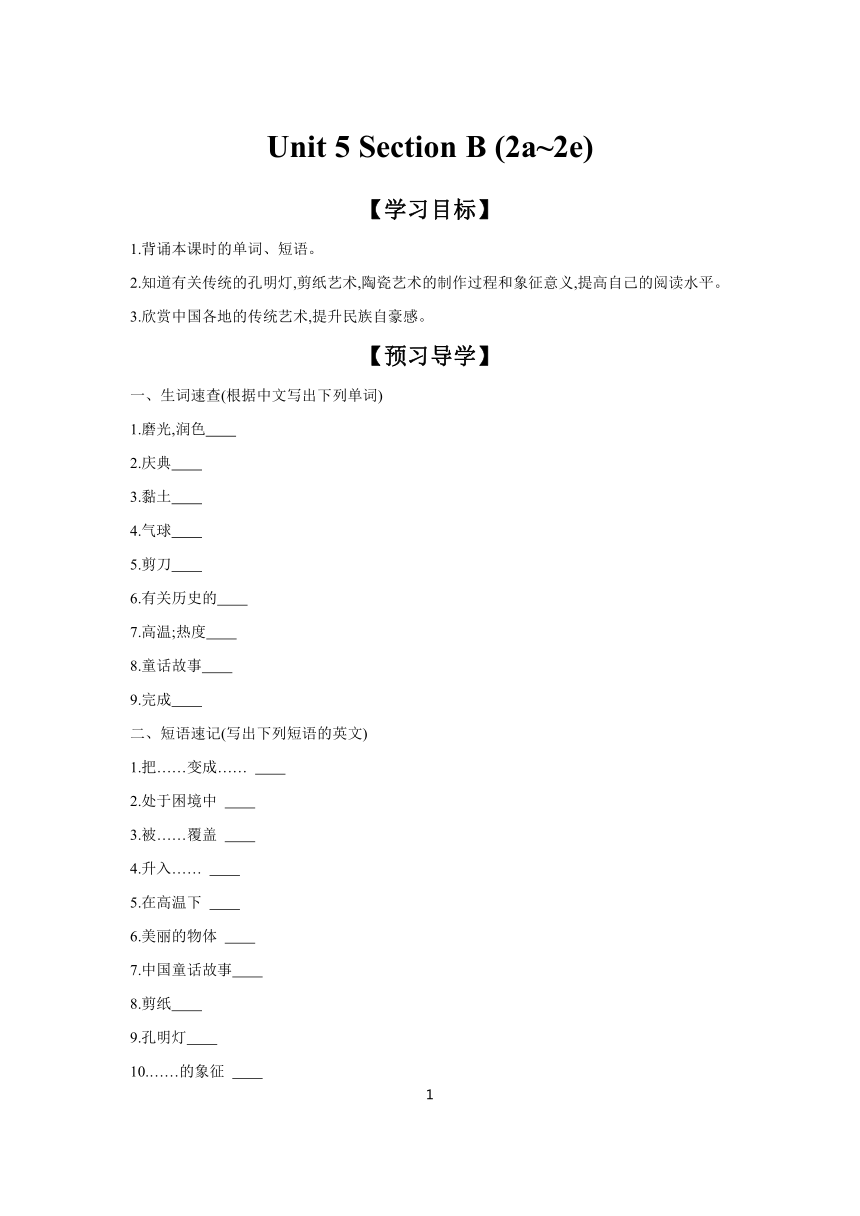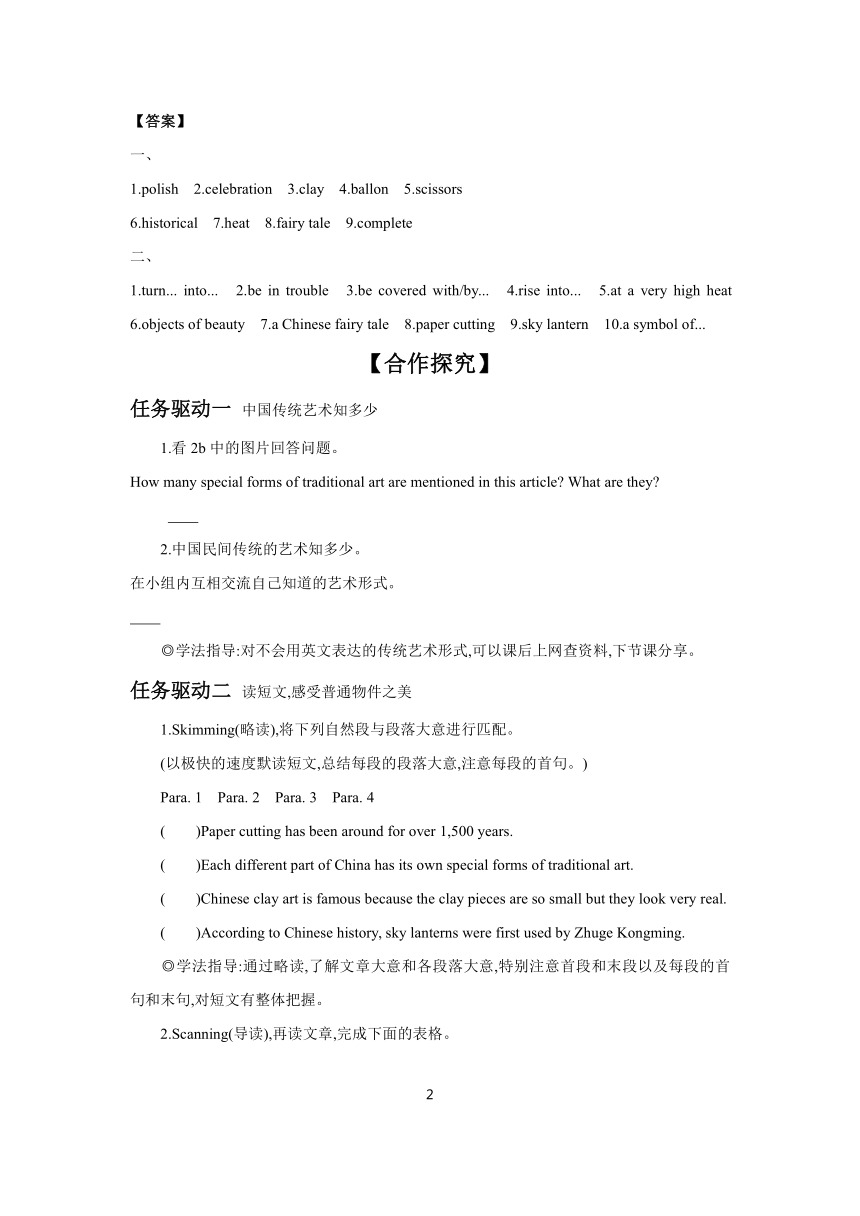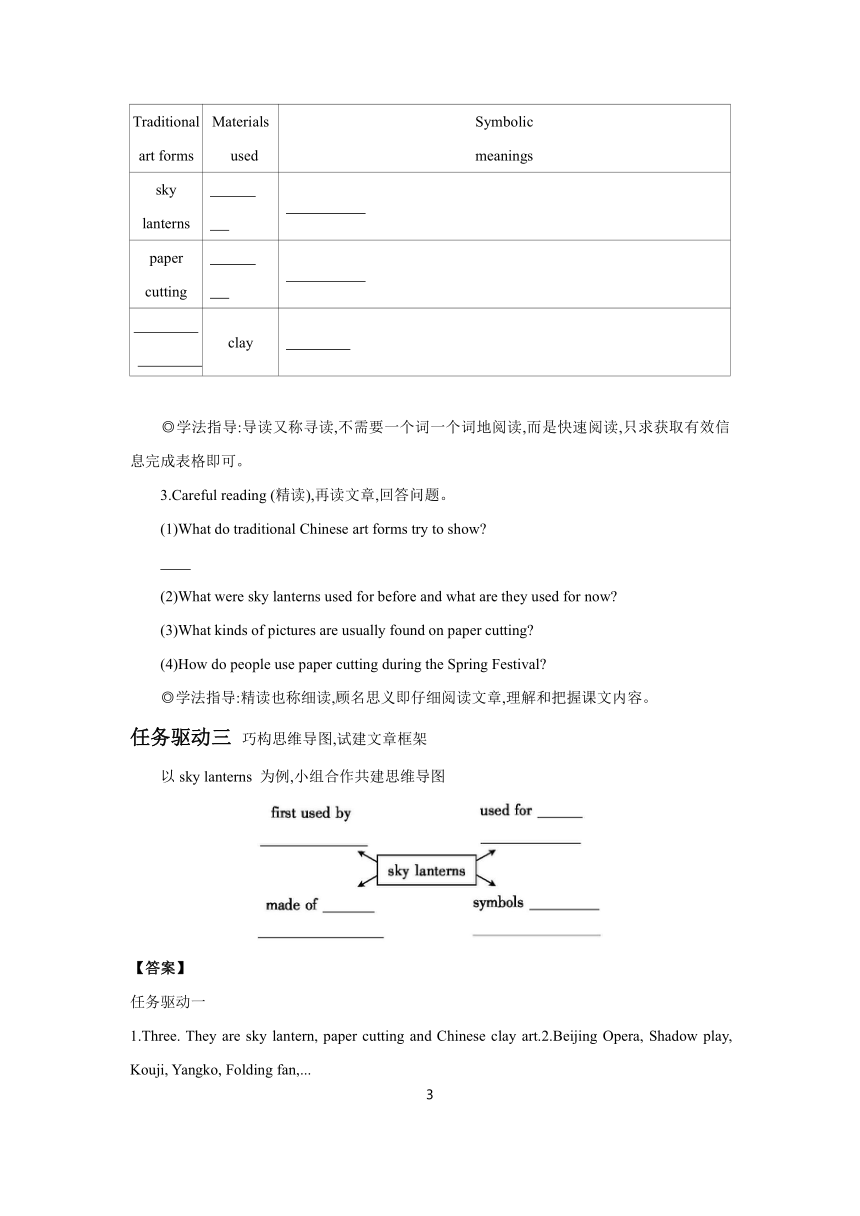Unit 5 What are the shirts made of?Section B (2a~2e) 学案人教版九年级全一册(含答案)
文档属性
| 名称 | Unit 5 What are the shirts made of?Section B (2a~2e) 学案人教版九年级全一册(含答案) |  | |
| 格式 | docx | ||
| 文件大小 | 44.1KB | ||
| 资源类型 | 教案 | ||
| 版本资源 | 人教新目标(Go for it)版 | ||
| 科目 | 英语 | ||
| 更新时间 | 2024-02-21 16:45:34 | ||
图片预览



文档简介
Unit 5 Section B (2a~2e)
【学习目标】
1.背诵本课时的单词、短语。
2.知道有关传统的孔明灯,剪纸艺术,陶瓷艺术的制作过程和象征意义,提高自己的阅读水平。
3.欣赏中国各地的传统艺术,提升民族自豪感。
【预习导学】
一、生词速查(根据中文写出下列单词)
1.磨光,润色
2.庆典
3.黏土
4.气球
5.剪刀
6.有关历史的
7.高温;热度
8.童话故事
9.完成
二、短语速记(写出下列短语的英文)
1.把……变成……
2.处于困境中
3.被……覆盖
4.升入……
5.在高温下
6.美丽的物体
7.中国童话故事
8.剪纸
9.孔明灯
10.……的象征
【答案】
一、
1.polish 2.celebration 3.clay 4.ballon 5.scissors
6.historical 7.heat 8.fairy tale 9.complete
二、
1.turn... into... 2.be in trouble 3.be covered with/by... 4.rise into... 5.at a very high heat 6.objects of beauty 7.a Chinese fairy tale 8.paper cutting 9.sky lantern 10.a symbol of...
【合作探究】
任务驱动一 中国传统艺术知多少
1.看2b中的图片回答问题。
How many special forms of traditional art are mentioned in this article What are they
2.中国民间传统的艺术知多少。
在小组内互相交流自己知道的艺术形式。
◎学法指导:对不会用英文表达的传统艺术形式,可以课后上网查资料,下节课分享。
任务驱动二 读短文,感受普通物件之美
1.Skimming(略读),将下列自然段与段落大意进行匹配。
(以极快的速度默读短文,总结每段的段落大意,注意每段的首句。)
Para. 1 Para. 2 Para. 3 Para. 4
( )Paper cutting has been around for over 1,500 years.
( )Each different part of China has its own special forms of traditional art.
( )Chinese clay art is famous because the clay pieces are so small but they look very real.
( )According to Chinese history, sky lanterns were first used by Zhuge Kongming.
◎学法指导:通过略读,了解文章大意和各段落大意,特别注意首段和末段以及每段的首句和末句,对短文有整体把握。
2.Scanning(导读),再读文章,完成下面的表格。
Traditional art forms Materials used Symbolic meanings
sky lanterns
paper cutting
clay
◎学法指导:导读又称寻读,不需要一个词一个词地阅读,而是快速阅读,只求获取有效信息完成表格即可。
3.Careful reading (精读),再读文章,回答问题。
(1)What do traditional Chinese art forms try to show
(2)What were sky lanterns used for before and what are they used for now
(3)What kinds of pictures are usually found on paper cutting
(4)How do people use paper cutting during the Spring Festival
◎学法指导:精读也称细读,顾名思义即仔细阅读文章,理解和把握课文内容。
任务驱动三 巧构思维导图,试建文章框架
以sky lanterns 为例,小组合作共建思维导图
【答案】
任务驱动一
1.Three. They are sky lantern, paper cutting and Chinese clay art.2.Beijing Opera, Shadow play, Kouji, Yangko, Folding fan,...
任务驱动二
1.Para 3 Para 1 Para 4 Para 2
2.bamboo and paper happiness and good wishes paper wishes of good luck and a happy new year Chinese clay art love for life and beauty
3.1)They try to show the things that are important in life, such as love, beauty and family.
2)They were used for asking for help when in trouble and now they are used at festivals and other celebrations.
3)The most common pictures are flowers, animals and things about Chinese history.
4)People often put them on windows, doors and walls to celebrate the Spring Festival.
任务驱动三
Zhuge Kongming asking help in the past bamboo, covered with paper happiness, good wishes
【知识超市】
[命题点一]
Each different part of China has its own special forms of traditional art. 中国的每个不同地区都有属于自己的特殊的传统艺术形式。
◎观察思考:
1.She has a tall and graceful form. 她有着高挑优雅的外形。
2.If you fill in this form, you can take books out of the library. 如果你填了这张表,你就可以把书带出图书馆。
3.A plan began to form in his mind.一个计划在他脑子里开始形成。
4.You should form good habits. 你应当养成好习惯。
◎用法总结:1.form表示“形式;形状”时, 可用作可数名词或不可数名词。例如: a new form of book “一本新型的书”。form 表示“表格”时是可数名词。例如: These forms are useful. 这些表格是有用的。
2.form作动词时, 意为“形成;构成;组成;养成”,指使事物以明确的轮廓、设计或结构而存在, 可用于具体事物, 也可用于如政府、球队等组织, 还可以用于如思想、体系等抽象事物。
对点自测
翻译
1.这位老太太好像喜欢任何形式的广场舞。
The old woman seems to like any of square dances.
2.请把你的名字写在这些表格上。
Please write your names on these .
[命题点二]
The pieces are usually cute children or lively characters from a Chinese fairy tale or historical story. 这些作品通常是可爱的孩子或出自中国童话或历史故事的生动形象。
◎观察思考:
1.He told a very lively story. 他讲了一个生动的故事。
2.This is a live/living fish.=This is a fish alive. 这是一条活鱼。
3.The living are more important to us than the dead. 活着的人对我们来说比死去的人更重要。
◎用法总结:lively、live、alive和living的异同
单词 用法
lively 意为“活泼的;快活的;生动的”, 可以指人或物, 可作定语或表语,但它没有“活着的”的意思
live 意为“活的;有生命的”, 通常只作前置定语, 且一般用于动物
alive 意为“活的;有生命的”时, 可作定语或表语, 只能置于名词后
living 意为“活的;有生命的”时, 可作定语或表语。一般置于名词前, 也可置于名词后。若其前加the时, 表示“活着的人”, 作主语时, 可看作复数
对点自测
用lively, live, living, alive填空
1.My little cousin Tom is very . We all like him.
2.Jack is helpful and he is a Lei Feng in our class.
3.They should take care of those fish in order to sell well.
4.Whether the traveler is or dead, we will find him.
【答案】
命题点一
对点自测
1.forms 2.forms
命题点二
对点自测
1.lively 2.living 3.live/living 4.alive
2
【学习目标】
1.背诵本课时的单词、短语。
2.知道有关传统的孔明灯,剪纸艺术,陶瓷艺术的制作过程和象征意义,提高自己的阅读水平。
3.欣赏中国各地的传统艺术,提升民族自豪感。
【预习导学】
一、生词速查(根据中文写出下列单词)
1.磨光,润色
2.庆典
3.黏土
4.气球
5.剪刀
6.有关历史的
7.高温;热度
8.童话故事
9.完成
二、短语速记(写出下列短语的英文)
1.把……变成……
2.处于困境中
3.被……覆盖
4.升入……
5.在高温下
6.美丽的物体
7.中国童话故事
8.剪纸
9.孔明灯
10.……的象征
【答案】
一、
1.polish 2.celebration 3.clay 4.ballon 5.scissors
6.historical 7.heat 8.fairy tale 9.complete
二、
1.turn... into... 2.be in trouble 3.be covered with/by... 4.rise into... 5.at a very high heat 6.objects of beauty 7.a Chinese fairy tale 8.paper cutting 9.sky lantern 10.a symbol of...
【合作探究】
任务驱动一 中国传统艺术知多少
1.看2b中的图片回答问题。
How many special forms of traditional art are mentioned in this article What are they
2.中国民间传统的艺术知多少。
在小组内互相交流自己知道的艺术形式。
◎学法指导:对不会用英文表达的传统艺术形式,可以课后上网查资料,下节课分享。
任务驱动二 读短文,感受普通物件之美
1.Skimming(略读),将下列自然段与段落大意进行匹配。
(以极快的速度默读短文,总结每段的段落大意,注意每段的首句。)
Para. 1 Para. 2 Para. 3 Para. 4
( )Paper cutting has been around for over 1,500 years.
( )Each different part of China has its own special forms of traditional art.
( )Chinese clay art is famous because the clay pieces are so small but they look very real.
( )According to Chinese history, sky lanterns were first used by Zhuge Kongming.
◎学法指导:通过略读,了解文章大意和各段落大意,特别注意首段和末段以及每段的首句和末句,对短文有整体把握。
2.Scanning(导读),再读文章,完成下面的表格。
Traditional art forms Materials used Symbolic meanings
sky lanterns
paper cutting
clay
◎学法指导:导读又称寻读,不需要一个词一个词地阅读,而是快速阅读,只求获取有效信息完成表格即可。
3.Careful reading (精读),再读文章,回答问题。
(1)What do traditional Chinese art forms try to show
(2)What were sky lanterns used for before and what are they used for now
(3)What kinds of pictures are usually found on paper cutting
(4)How do people use paper cutting during the Spring Festival
◎学法指导:精读也称细读,顾名思义即仔细阅读文章,理解和把握课文内容。
任务驱动三 巧构思维导图,试建文章框架
以sky lanterns 为例,小组合作共建思维导图
【答案】
任务驱动一
1.Three. They are sky lantern, paper cutting and Chinese clay art.2.Beijing Opera, Shadow play, Kouji, Yangko, Folding fan,...
任务驱动二
1.Para 3 Para 1 Para 4 Para 2
2.bamboo and paper happiness and good wishes paper wishes of good luck and a happy new year Chinese clay art love for life and beauty
3.1)They try to show the things that are important in life, such as love, beauty and family.
2)They were used for asking for help when in trouble and now they are used at festivals and other celebrations.
3)The most common pictures are flowers, animals and things about Chinese history.
4)People often put them on windows, doors and walls to celebrate the Spring Festival.
任务驱动三
Zhuge Kongming asking help in the past bamboo, covered with paper happiness, good wishes
【知识超市】
[命题点一]
Each different part of China has its own special forms of traditional art. 中国的每个不同地区都有属于自己的特殊的传统艺术形式。
◎观察思考:
1.She has a tall and graceful form. 她有着高挑优雅的外形。
2.If you fill in this form, you can take books out of the library. 如果你填了这张表,你就可以把书带出图书馆。
3.A plan began to form in his mind.一个计划在他脑子里开始形成。
4.You should form good habits. 你应当养成好习惯。
◎用法总结:1.form表示“形式;形状”时, 可用作可数名词或不可数名词。例如: a new form of book “一本新型的书”。form 表示“表格”时是可数名词。例如: These forms are useful. 这些表格是有用的。
2.form作动词时, 意为“形成;构成;组成;养成”,指使事物以明确的轮廓、设计或结构而存在, 可用于具体事物, 也可用于如政府、球队等组织, 还可以用于如思想、体系等抽象事物。
对点自测
翻译
1.这位老太太好像喜欢任何形式的广场舞。
The old woman seems to like any of square dances.
2.请把你的名字写在这些表格上。
Please write your names on these .
[命题点二]
The pieces are usually cute children or lively characters from a Chinese fairy tale or historical story. 这些作品通常是可爱的孩子或出自中国童话或历史故事的生动形象。
◎观察思考:
1.He told a very lively story. 他讲了一个生动的故事。
2.This is a live/living fish.=This is a fish alive. 这是一条活鱼。
3.The living are more important to us than the dead. 活着的人对我们来说比死去的人更重要。
◎用法总结:lively、live、alive和living的异同
单词 用法
lively 意为“活泼的;快活的;生动的”, 可以指人或物, 可作定语或表语,但它没有“活着的”的意思
live 意为“活的;有生命的”, 通常只作前置定语, 且一般用于动物
alive 意为“活的;有生命的”时, 可作定语或表语, 只能置于名词后
living 意为“活的;有生命的”时, 可作定语或表语。一般置于名词前, 也可置于名词后。若其前加the时, 表示“活着的人”, 作主语时, 可看作复数
对点自测
用lively, live, living, alive填空
1.My little cousin Tom is very . We all like him.
2.Jack is helpful and he is a Lei Feng in our class.
3.They should take care of those fish in order to sell well.
4.Whether the traveler is or dead, we will find him.
【答案】
命题点一
对点自测
1.forms 2.forms
命题点二
对点自测
1.lively 2.living 3.live/living 4.alive
2
同课章节目录
- Unit 1 How can we become good learners.
- Section A
- Section B
- Unit 2 I think that mooncakes are delicious!
- Section A
- Section B
- Unit 3 Could you please tell me where the restroom
- Section A
- Section B
- Unit 4 I used to be afraid of the dark.
- Section A
- Section B
- Unit 5 What are the shirts made of?
- Section A
- Section B
- Review of Units 1-5
- Unit 6 When was it invented?
- Section A
- Section B
- Unit 7 Teenagers should be allowed to choose their
- Section A
- Section B
- Unit 8 It must belong to Carla.
- Section A
- Section B
- Unit 9 I like music that I can dance to.
- Section A
- Section B
- Unit 10 You're supposed to shake hands.
- Section A
- Section B
- Review of Units 6-10
- Unit 11 Sad movies make me cry.
- Section A
- Section B
- Unit 12 Life is full of the unexpected
- Section A
- Section B
- Unit 13 We're trying to save the earth!
- Section A
- Section B
- Unit 14 I remember meeting all of you in Grade 7.
- Section A
- Section B
- Review of Units 11-14
